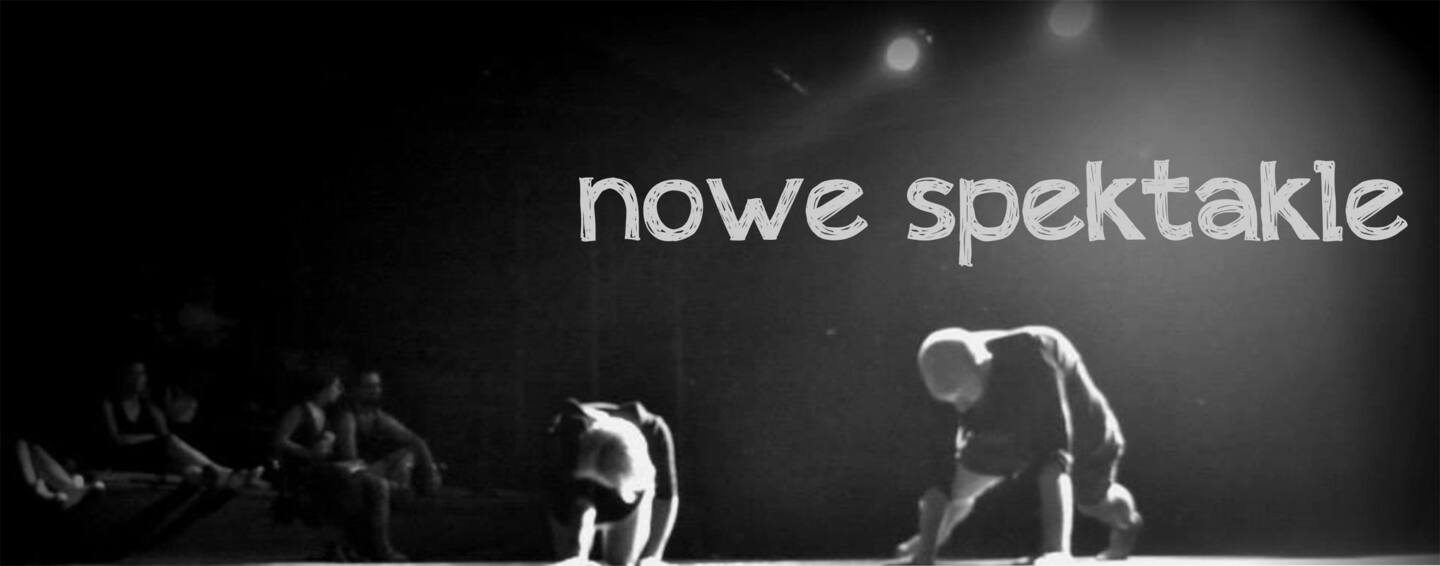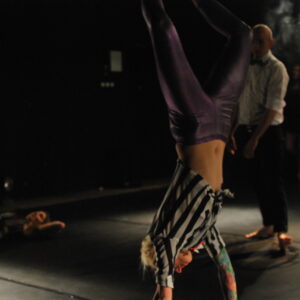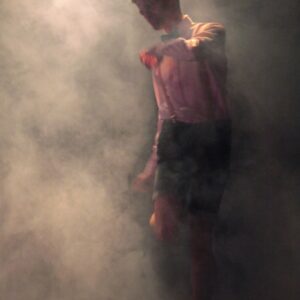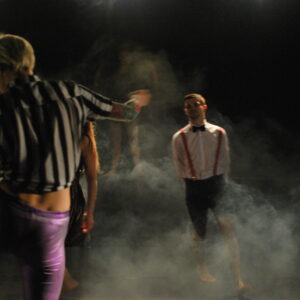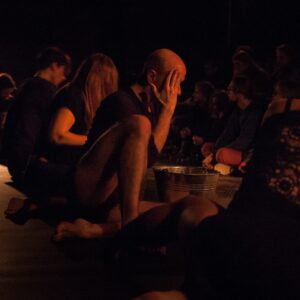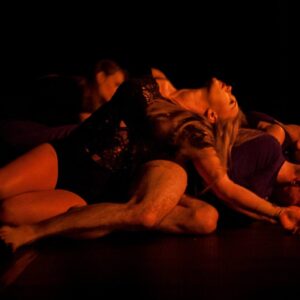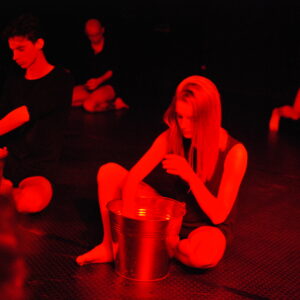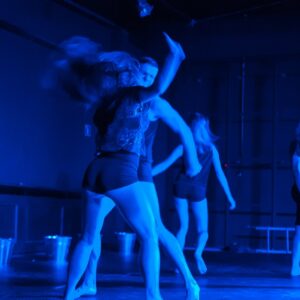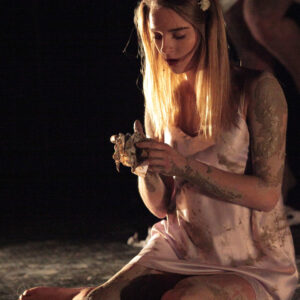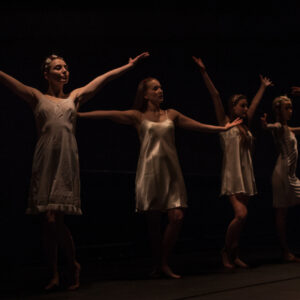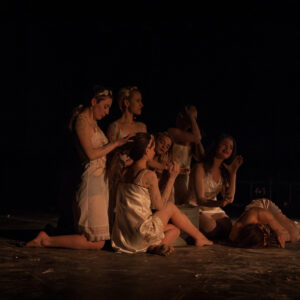What hums in empty shells and in words-heavy heads?
"Shells", "Uterus" - dir. and chorus Marek Zadłużny - Dance Theater Studio in Zielona Góra
The Department of Culture Animation and Androginics of the University of Zielona Góra hosted a show of the latest performances of the Dance Theater Studio, operated by Marek Zadłużny. The young independent dancers achieved the impossible on stage - with the lightness of movement, they removed the weight of really serious problems, creating performances in which the opposing elements harmonize: ugliness and beauty, freedom and entanglement, silence and screaming.
The performances of Pracownia Teatr Teatr Tańca were inaugurated by a welcome performance by Grupa Laboratoryjna, which is a short improvisation, which can be interpreted as a metaphor for the running away of time and the mad rush of an individual trying to keep up with it (which was aptly illustrated by turning the lying dancers around their axis, clockwise ). However, it was just a "warm-up" introducing viewers to the atmosphere of the shows prepared by the Studio, dealing with much more serious issues.
The first of them, directed by Marek Zadłużny and prepared according to his choreography, is entitled "Shells". It begins with the entry on the stage of characters dressed in black (in these roles: Justyna Śmietańska, Natalia Dziadek, Katarzyna Pawlak, Julita Polańska, Paulina Niemiec, Łukasz Szpilski, Radosław Bajon and Marek Zadłużny) carrying tin buckets of water. picking up a tear and tearing it off one's face (...), smashing large clay vessels against the ground, the rattling of which in the cracking makes even more sadness. The figures with a noise put their buckets down and arrange themselves in a swirled swirl similar to piles of human bodies,known from the paintings of the final judgment by Hieronim Bosch and Hans Memling or the afterlife of Zdzisław Beksiński. Huddled, humbly waiting for the impending death, when suddenly their bodies are filled with breath again. This breath - loud and accentuated in all of Debt's performances - seems to be a universal language of communication for the director. In "Shells", there is hope that the element of life still smolders in the human body, thanks to which the inevitable end can be delayed for a moment. The characters expose this breath, rising and falling like one large organism, and then they rise to dance again The joy of these few moments of death, however, does not last long, and then the dancers lose hold of their increasingly passive limbs.The actors perfectly convey the horror of the body resulting from the soul's irrevocable departure from it. They fight him by lifting his drooping knees with their hands, repeatedly falling over and standing up. In the end, the heroes decide to reach for the buckets, believing that water, culturally perceived as a symbol of life, can still save them. They drink it, pour it over their faces and rub the drops on their weakening bodies. Unfortunately, they quickly learn that nothing can extend their lives. So with a clatter they abandon empty vessels, to which they become more and more like with their agony.they pour it over their faces and rub its drops against weakening bodies. Unfortunately, they quickly learn that nothing can extend their life. So with a clatter they abandon empty vessels, to which they become more and more like with their agony.they pour it over their faces and rub its drops against weakening bodies. Unfortunately, they quickly learn that nothing can extend their life. So with a clatter they abandon empty vessels, to which they become more and more like with their agony.
The inspiration for the creation of "Shells" was - as in the announcement of the performance - the view of dried shells and the questions provoked by it: "What happens to the body when the soul leaves it? Is it just a shell - an abandoned, sterile, meaningless space? is the body the actual vessel, the shape of which is taken by the surrendered soul? " Such an approach to the subject matter brings a surprisingly fresh and original view of the issue over which theologians, philosophers and scientists have been arguing for centuries. The issue that bothers all sides of this dispute remains the existence of the soul and the directions of its supposed posthumous journeys, in line with the vertical or horizontal scheme. Researchers and clergymen try to find more evidence thatthat the death of a man is not the end of his existence (indicating, for example, the fact that the bodies of deceased people are 21 grams lighter than during their lifetime, or by citing the testimonies of living with the spirits of their dead loved ones). Hardly anyone is interested in what happens next with the body. And yet this is an exceptionally important problem, valid at a time when the progress of medicine seems to make it possible to learn all the secrets of our physicality. The German plastinator Gunther von Hagens is constantly trying to deal with this topic by creating exhibits from human corpses, which can be perceived as a kind of attempt to extend the life of the body. However, the controversy raised by this art form is blurred by the fundamental questions underlying it about how the death of one's own body would be perceived by a beautiful model, actor,which moves crowds of viewers with facial expressions and gestures, and finally - a dancer who uses the body as the most important means of expression. These are the questions the answer is "Shells".
The second of the performances choreographed by Marek Zadłużny, this time supported by his assistant, Radosław Bajon, was "Uterus", meaning "Uterus" from Latin. The title itself suggests that the performance is set in a female world. It is supported by the quotation from Karolina Rosocka's poem: a woman who is afraid of being too light, leaks through her fingers (...) wants to be polite, nods at the table (...) finally stripped of her femininity is born. The dancers appearing in "Uterus" (Kalina Grupa, Karolina Pachurka, Julita Polańska, Julia Abramowicz, Natalia Dziadek, Agata Kierońska, Julia Piwowarczyk, Kinga Górska and Paulina Niemiec) play the role of the bride and the accompanying bridesmaids. The heroines dressed in white petticoats, with glittering diadems on their heads,they want to emphasize their purity and innocence. They manifest it with the lightness of dancing, which is accompanied by a natural joy and a will to live, when suddenly, from anonymous letters (symbolized by muddy sheets found in the vats), they learn that they have been defamed by someone. In an instant, their euphoria fades away to give way to bitterness. The heroines cannot believe what they have read. They tear through the letters as if it might invalidate the event that has happened, but the words written on the sheets still fill their heads with screams of painful slander. Women try to explain themselves by showing viewers their clean hands. However, they notice with horror that their bodies and snow-white petticoats are becoming more and more covered with mud, which they will no longer be able to wash off themselves.from anonymous letters (symbolized by muddy sheets found in the vat), they learn that they have been defamed by someone. In an instant, their euphoria fades to give way to bitterness. The heroines cannot believe what they have read. They tear through the letters as if it might invalidate the event that has happened, but the words written on the sheets still fill their heads with screams of painful slander. Women try to explain themselves by showing viewers their clean hands. However, they notice with horror that their bodies and snow-white petticoats are becoming more and more covered with mud, which they will no longer be able to wash off themselves.from anonymous letters (symbolized by muddy sheets found in the vat), they learn that they have been defamed by someone. In an instant, their euphoria fades to give way to bitterness. The heroines cannot believe what they have read. They tear through the letters as if it might invalidate the event that has happened, but the words written on the sheets still fill their heads with screams of painful slander. Women try to explain themselves by showing viewers their clean hands. However, they notice with horror that their bodies and snow-white petticoats are becoming more and more covered with mud, which they will no longer be able to wash off themselves.what they read. They tear through the letters as if it might invalidate the event that has happened, but the words written on the sheets still fill their heads with screams of painful slander. Women try to explain themselves by showing viewers their clean hands. However, they notice with horror that their bodies and snow-white petticoats are becoming more and more covered with mud, which they will no longer be able to wash off themselves.what they read. They tear through the letters as if it might invalidate the event that has happened, but the words written on the sheets still fill their heads with screams of painful slander. Women try to explain themselves by showing viewers their clean hands. However, they notice with horror that their bodies and snow-white petticoats are becoming more and more covered with mud, which they will no longer be able to wash off themselves.
The problem of slander presented in "Uterus" is one of the most pressing issues in the era of Facebook, internet forums and gossip portals that our society has still not found a solution to. mistakes made by men and their life choices - it seems to affect them more. - these are contemporary, online versions of the muddy pages shown in Uterus, which led to suicide in many of their victims.However, Marek Debłużny's performance brings a positive ending. Its protagonists come to the conclusion that the most important thing is to live in harmony with yourself and your own truth. The ugliness of the costumes, patches and false appearances cannot destroy their inner beauty. Calmed down, they perform the dance of freedom, giving hope to those who once suffered a similar fate.
The show, consisting of Marek Zadłużny's premieres, was enriched by two funny etudes choreographed by Justyna Śmietańska ("Heteronyms" and a special solo by a dancer), which immediately put the audience in a cheerful mood and became a counterbalance to the other performances.
The whole show, prepared by the Dance Theater Studio in Zielona Góra, certainly convinced the audience that the stage movement, arranged on the basis of humanistic theoretical thought, can carry a much deeper message today than avant-garde performances that use tattered cliches, trying to seduce the audience with their mumbling, vulgar and ever-increasing it's more obscene content.
"Shells", "Uterus", Studio of Dance Theater in Zielona Góra, dir. and dr Marek Zadłużny
Agnieszka Moroz
The Theater Journal
on February 14, 2015
